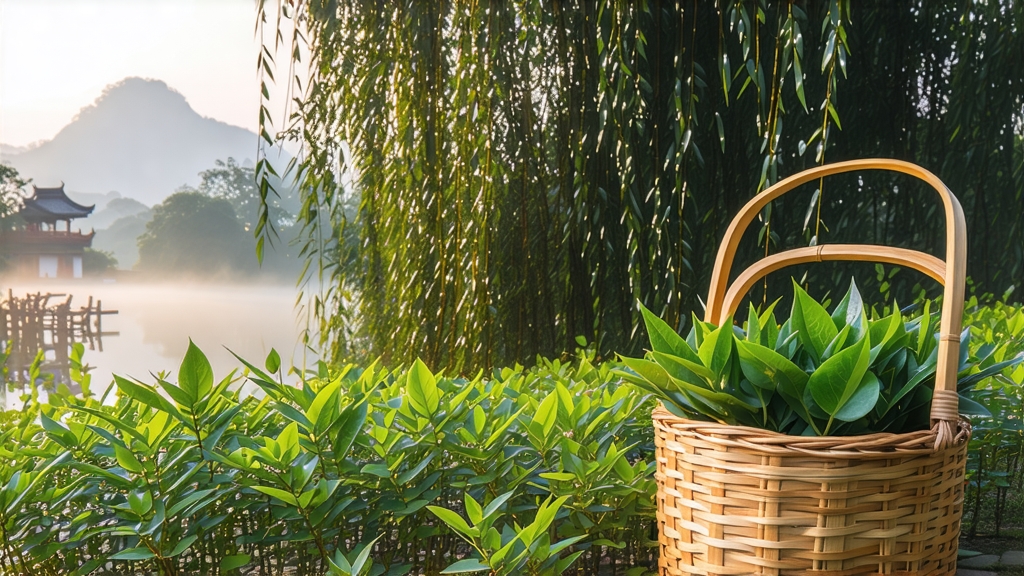
Longjing, often spelled Lung Ching in older romanization, is the most celebrated among China’s several hundred green teas. Its name translates literally as “Dragon-Well,” a reference to a spring near Longjing Village on the western shore of Hangzhou’s West Lake. International travelers who have sipped it in a lakeside teahouse frequently remember two things: a gentle, chestnut-sweet fragrance and a pale jade liquor that seems to capture early spring sunlight. Yet behind that quiet cup lies ten centuries of dynastic patronage, microscopic grading distinctions, and a hand-firing technique so precise that master makers compare it to playing a guqin—one wrong note and the melody is lost.
Historical records first mention tea gardens on the West Lake hills during the Tang dynasty (618-907), but Longjing did not acquire its imperial reputation until the early Qing. The Kangxi Emperor (r. 1661-1722) included the tea among his birthday tributes, and his grandson Qianlong (r. 1735-1796) is said to have pocketed a few bushes after visiting the Hugong Temple below Lion Peak. The emperor’s personal seal elevated eighteen specific bushes to “imperial tree” status; descendants of those bushes still grow on Shi-feng (Lion Peak) and are auctioned annually for more per gram than gold. Republican-era scholars divided the producing zone into four sub-appellations—Shi-feng, Mei-jia-wu, Weng-jia-shan and Hu-pao (Tiger Run)—each offering micro-climatic nuances comparable to the terroir differences in Burgundy.
Botanically, Longjing is almost exclusively the Shi-feng qunti cultivar, a small-leaf Camellia sinensis var. sinensis landrace that evolved on these granite slopes. Its leaves are unusually thin, allowing rapid heat penetration during pan-firing, and they contain a high ratio of theanine to catechins, the biochemical basis for Longjing’s famed “sweet after-bitter” balance. In the 1970s agronomists released clone varieties such as Longjing #43 and #117 to extend the harvest window, but connoisseurs still pay premiums for the traditional qunti leaf whose picking season lasts barely twenty days between Qingming and Grain Rain.
Harvest begins before dawn when leaf moisture is highest and enzymatic activity lowest. Pickers—usually experienced women who can discern one tender bud plus one unfolded leaf at fingertip speed—drop the shoots into wicker baskets lined with thin bamboo leaves to prevent bruising. The classic grade, qiyizhen (“one flag, one spear”), demands a single unopened bud sheathed by a partially opened leaf resembling a miniature banner and spear. Lower grades accept two leaves, but anything coarser is diverted into cheaper “West Lake green” that legally cannot carry the Longjing name.
Within four hours the leaves must reach the firing room, a modest farmhouse kitchen whose only modern concession is an electric thermostat. Here the pan master, always male in local tradition, controls two cast-iron woks set into a brick hearth. The first wok is pre-heated to 280 °C, hot enough to puff a drop of water into glass beads. He throws in 250 g of fresh leaf and immediately begins the ten-minute “kill-green” sequence: pressing, shaking, tossing, and finally stroking the leaves against the wok wall in a motion called “push-row-press-grasp.” The goal is to destroy leaf enzymes while locking in jade color, yet the leaves must never scorch; the sound should resemble light rain on a silk umbrella. Temperature is then lowered to 80 °C for the second wok, where the master shapes each leaf into the famous flat, smooth strip reminiscent of an ancient sword blade. A single batch demands 250–300 hand movements repeated for twenty-five minutes, after which moisture drops to 6 %. No rolling, no baking, no secondary drying—Longjing is finished leaf once it leaves the wok.
Because the tea is only lightly oxidized, storage is critical. Traditional practice wraps 50 g portions in rice paper, slips them into a fired earthen jar, and buries the jar in a lime pit to absorb ambient humidity. Modern exporters flush nitrogen into vacuum pouches, yet the finest lots still travel with a sachet of quicklime, a nod to Song-dynasty technology.
To brew Longjing respectfully, one needs not the gongfu paraphernalia associated with oolong but rather a tall, clear glass that displays the “tea dance.”